Why a Visit to Copenhagen Gave Me Slightly More Hope for Denver’s Transport System
The safe and easily navigable streets of Denmark's largest metro area are not some magical accident in a far away land. They're the result of pragmatic decision-making.

I wasn’t alive when the car came to dominate American cities and towns. That’s just how it’s always been for me and most of the country’s populace, whether we drive or not. As Americans we have about as much say in living under the rule of the automobile as we do over a birthmark.
But with more than 40,000 people dying yearly in our car-centric system, it feels like a scar.
I recently visited Copenhagen, a place where kids are born into a society with different values. Those values equate to far fewer people dying just trying to move around. Those values have created a built environment that engenders healthy people who don’t have to sink $8,500 a year into owning a car. They can get to work, school, and the grocery store reliably without one.
Despite reading and writing about the biking, walking, and transit feats of Copenhagen, the Coloradan in me had always assumed some level of hyperbole. That attitude began dissipating when I stepped off the plane to see a protected bike lane at the airport. I took the automated train underground and into the city.

Those were the first of innumerable mouth-dropping moments I had about Copenhagen’s transport infrastructure. My American friends endured my awe for four days while we biked, walked, and transited seamlessly around an unfamiliar city.
We wheeled around on a network of 242 miles worth of stress-free bikeways. Seemingly never-ending raised bike lanes whooshed us through affluent neighborhoods and underprivileged ones, alongside car traffic, safely taking us anywhere we wanted to go. Kids rode alongside cargo bikes full of groceries, furniture, and even lumber. Bike signals made navigating the system a cinch.
Both of my friends like to bike, but they primarily drive at home in Denver. One told me he felt more comfortable biking on foreign streets than on Downing Street. In other words, H.C. Andersens Boulevard, Copenhagen’s heavily trafficked, six-lane central arterial, felt safer than a two-lane neighborhood street in Denver.

When walking, people on bikes deferred to us. “It’s okay, you have the right of way!” one local on a bike exclaimed after my buddy apologized for crossing his path. Short crossings, long pedestrian signals, and pedestrian islands on wider streets made walking places easy. Because street designs prioritized pedestrians, few people crossed against signals or mid-block. They didn’t have to — unlike on Colfax and Federal, where wide, infrequent crossings mean risking life and limb to swiftly arrive at your destination.
A Copenhagen taxi driver told me that getting his driver’s license depended on a strict deference for people walking and biking. That attitude played out on the streets, where hyper-aware drivers patiently waited for people walking and biking to clear intersections before turning — instead of trying to “beat” them with a me-first maneuver.
Copenhagen residents walked, biked, or took transit for 67 percent of all trips in 2014. In 2016 the number of bikes surpassed the number of cars. More than 50 percent of the city’s commute trips happen on a bike. In Denver, 73 percent of all commute trips are by car.

But there’s a silver lining. Copenhagen’s transport system did not happen by accident. The success it enjoys today resulted from deliberate policy decisions in the 60s and 70s to invest in biking and walking infrastructure, pedestrianize streets, reduce parking area by 3 percent per year, and reject an American-style highway system that threatened the city’s vitality.
Denver has different decisions to make. For example, the Hancock and Hickenlooper administrations’ disastrous plan to pave over low-income, majority-Latino neighborhoods to expand I-70 should be the first thing to go. And if Denver is to have a streets renaissance, the process will have to be inclusive and contextual.
But seeing Copenhagen first hand reminded me that we’re not knotted to car dependence just because that’s how it’s been for a while. Our current plight of traffic, pollution, poor public health, and crash-related deaths is solvable with bold policy decisions and investments to swing the status quo.
It’s easy to claim projects like bus rapid transit on Colfax and the Broadway redesign are dead on arrival because America. It’s more challenging, but a lot more helpful, to see Denver at a fork in the road like Copenhagen once was, with a chance to take the smart path.
As we know, the results can be moving.





